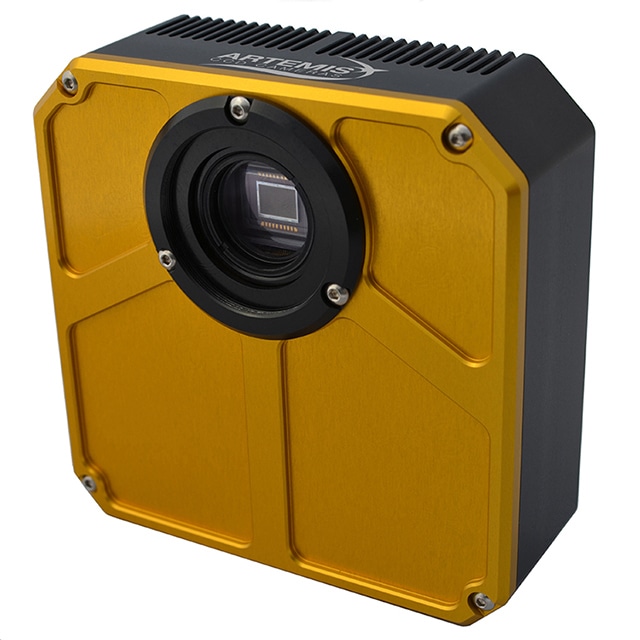AZoM talks to Chris Andrews from Artemis CCD discussing the latest innovations in CCD technology at Artemis CCD Ltd.
Can you give a brief overview of Artemis CCD ltd.? The type of products you produce and markets you operate in?
We are a fast growing British company dedicated to producing cooled CCD cameras for the Science sector as well as amateur astronomy where we are the market leader in Europe. Our cameras are based around CCD sensors from Sony and Truesense (which used to be part of the Kodak group) and are designed to provide the highest image quality in low light applications while remaining very affordable!
Could you give a brief overview into the concept of cooled CCD cameras? Their purpose, applications and the innovation behind the products you produce at Artemis CCD?
For many applications where image quality is a priority, CCD sensors are the technology of choice. In low light situations where long exposures are required, the sensor has to operate continuously for many seconds or even several minutes and cooling the sensor manages the build-up of thermal currents which are detrimental to image quality. By cooling the CCD with a thermoelectric element, the cleanest images can be obtained. In scientific applications, this is critical for capturing low light levels from processes such as fluorescence and chemi-luminescence.
Which types of market do Artemis CCD currently operate in and supply to?
Our Artemis CCD cameras are ideal for most low light applications and our customer base ranges from a Medical Physics Research Department in Chinese hospital to a Californian company producing spectroscopy equipment for airport screening! Many universities find that our products fit their budgets very nicely and one of my key tasks is to make us known to as many OEMs as possible which may already use cooled CCD cameras but are unaware of the benefits our products can offer.
On your website you mention that Artemis products offer “The Gold Standard” of low-light imaging. Can you explain the requirements of low-light imaging and how Artemis CCD products are unique.
We pride ourselves on the image quality produced by our products. That, after all is the number one goal of most of our customers who need cameras for low light applications. We are expanding our range significantly with the VS cameras, offering a wide choice of CCD sensors in a camera body which provides extended cooling, an easy to integrate form factor and a feature set which has been developed specifically from our customers’ needs and wishes.

VS14 TE Cooled CCD Camera designed for Low Light Microscopy and OEM Applications.
Spectroscopy is an application where CCD sensors are used. What are the types of solutions that Artemis products help this area?
Wide band spectroscopy equipment often use high-end CCD sensors as their detectors. The sensors used in Artemis CCD cameras offer an excellent alternative as a complete 2D array or even by mimicking a linear sensor. The key feature Artemis CCD offers for these customers is asymmetric pixel binning which means that in a 2 dimensional array, the customer can specify differing values for X and Y binning. Together with a selectable Region of Interest, our product range offers a cost effective solution for many people.
What are some of the challenges that face OEM Integrators for cooled CCD cameras? And how does the work that takes place at Artemis CCD overcome these challenges?
We have many years experience working with leading OEM integrators and we listen carefully so I feel we understand their needs pretty well. They are looking for a reliable product combined with excellent performance and a compact form factor which provides a number of options for mechanical fixing. OEMs currently buying high end cameras yet do not need all the features they provide often find our products to be a lower cost alternative without compromising their system performance. It’s important too to understand that one size doesn’t fit all and that extends equally to software integration as well as mechanical fitment. We don’t charge for our imaging software, SDK or drivers so prospective customers can get a good idea how to integrate our products even before they receive the first camera.
Another string to our bow in the Life Sciences market is that our CEO worked as an immunologist before founding Artemis CCD and his hands on experience helps to reassure our customers that we understand their applications in detail and that we can offer full support to help them choose the best Artemis CCD camera for their own product.

FS14 TE-cooled CCD Camera for OEM Applications.
Are there any examples or Case Studies where Artemis products have been able to overcome the challenges faced with OEM Integrators for cooled CCD Cameras?
All our OEM customers find themselves in a competitive market so they are naturally quite guarded in the information they release. One example we can talk about is the Syngene brand of imaging systems produced by our sister company. Syngene systems enjoy a fine reputation for image quality whether it’s for Gel Documentation, chemi-luminescence or (Synbiosis) Colony cell counters and they all incorporate our cameras.
A quick glance at our Applications page also gives you some idea of the diverse range of products which find a home for our cameras.
Can you tell us about upcoming plans? What can we expect from Artemis in the future?
Now that the VS range is becoming established we can turn our R&D attention to our large format cameras. In the next twelve months we have plans to refresh our LF cameras and extend the range of Truesense CCD based products on offer so watch out for announcements on https://www.atik-cameras.com/ and of course press releases on AZo!
About Chris Andrews

After 35 years in the high reliability electronics sector, Chris was delighted to lend his experience to the challenge of developing the scientific camera side of the business for Artemis CCD Limited.
In a little over a year, the brand has been re-established as a strong contender in this niche but competitive market. With continuous development of the product range, the company is enjoying significant growth with an expanding world-wide customer base and this is set to continue for many years to come.
Disclaimer: The views expressed here are those of the interviewee and do not necessarily represent the views of AZoM.com Limited (T/A) AZoNetwork, the owner and operator of this website. This disclaimer forms part of the Terms and Conditions of use of this website.